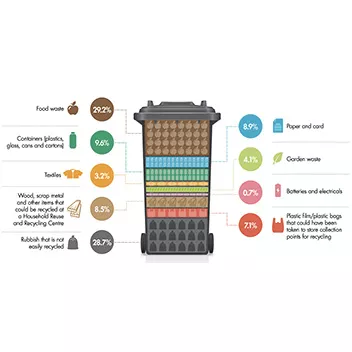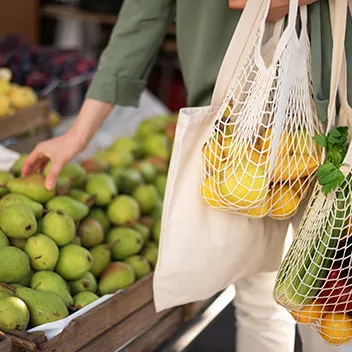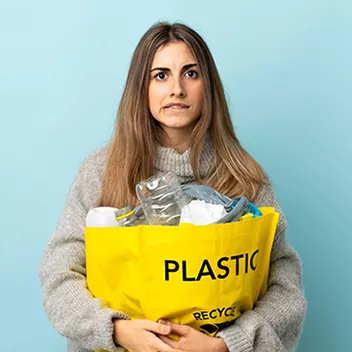
Waste into energy
Waste that cannot be recycled is treated at a state-of-the-art energy from waste facility in Beddington, Sutton.
Separating and sorting your waste out into different bins is just the start of an amazing journey.
What happens to your recycling after it’s been collected? Where does it go? What’s it turned into? You will find the answers to all those questions here.
86% of the recycling and rubbish generated by households across Croydon, Kingston, Merton and Sutton is treated or reprocessed in the UK. The remaining 14% is sent abroad.*
All the materials we send abroad are recycled – we only work with reputable companies who go to great lengths to ensure that the materials are handled carefully and in an environmentally sustainable way.
What happens to your recycling after it’s been collected? Where does it go? What’s it turned into?
Amount collected each year: 30,000 tonnes (approx.)
Where’s it taken? Some food waste (around 5,000 tonnes) is direct-delivered by the collection vehicles to a local Anaerobic Digestion (AD) facility in Mitcham operated by Bio Collectors. The rest is bulked at Waste Transfer Stations in either Mitcham or Kingston before being transported in HGVs to an Anaerobic Digestion facility in either Surrey (operated by Severn Trent Green Power) or Buckinghamshire (operated by Olleco).
What’s it turned into? Two things actually: Renewable energy which fuels UK homes and businesses and a nutrient-rich liquid bio-fertiliser which is used by UK farmers to help grow the fruit and vegetables that end up back on our plates. The gasses produced during the digestion process (which takes about 75 days) are captured and used to drive a turbine which generates electricity. The electricity is fed into the National Grid.
Watch the film:

Note: this video accurately represents what happened to food waste when it was filmed in September 2019. It still provides a valuable insight into the recycling process and has been left here for your enjoyment. Please also refer to the text above for a more up-to-date explanation of what currently happens to your food waste.
Amount collected each year: 30,000 tonnes (approx.)
Where’s it taken? To Waste Transfer Stations in Croydon (Stubbs Mead Depot) or Kingston (Villiers Road) where it is bulked before being transported in HGVs to the DS Smith paper mill in Kemsley, Kent.
What’s it turned into? More paper-based products. The waste paper and card is washed to remove inks, staples and glues, and then mixed with water to create a slurry. By adding different materials to this slurry, a variety of paper-based products can be created. For more information on the paper and card recycling process, watch this video from Recycle Now: paper – how is it recycled?
Watch the film:

Note: this video accurately represents what happened to paper and card recycling when it was filmed in September 2019. It still provides a valuable insight into the recycling process and has been left here for your enjoyment. Please also refer to the text above for a more up-to-date explanation of what currently happens to your paper and card recycling.
Amount collected each year: 53,000 tonnes (approx.)
Where’s it taken? To Waste Transfer Stations in Kingston (Villiers Road), Sutton (Beddington Lane), Merton (Garth Road) or Croydon (Endeavour Way) where it is bulked before being transported in HGVs to one of four recycling sorting facilities or MRFs (‘Materials Recycling Facility’)*:
The MRFs in Rainham, Wolverhampton and Southwark are all operated by Veolia. The MRF in Crayford is run by N+P.
Once the recycling has been sorted, it is baled (squashed into cubes) and sold on to reprocessors who turn the materials into new products.
What’s it turned into?
Watch the film:

Note: this video accurately represents what happened to plastics, glass, cans and cartons recycling when it was filmed in September 2019. It still provides a valuable insight into the recycling process and has been left here for your enjoyment. Please also refer to the text above for a more up-to-date explanation of what currently happens to your plastics, glass, cans and cartons recycling.
Amount collected each year: 30,000 tonnes (approx.) – from households that subscribe to the garden waste collection service or taken by residents to their local Household Reuse and Recycling Centre.
Where’s it taken? Garden waste is bulked at Waste Transfer Stations in either Morden or Kingston before being transported in HGVs to a compositing facility at Laverstoke Park Farm in Hampshire
What’s it turned into? Peat-free, high-quality compost.
* Figures based on 2019/20 Waste Data Flow
** Figures based on October – December 2022 data

Waste that cannot be recycled is treated at a state-of-the-art energy from waste facility in Beddington, Sutton.
Most preferred environmental option
Reducing waste is the most preferred option. Minimising the amount of waste we produce in the first place is by far the most effective way of reducing the impact we have on the environment.
Learn moreWhen waste is created, the waste hierarchy prioritises reuse. Where possible, reusing products and materials before it becomes waste is the next best option. By cleaning, repairing and refurbishing items, we can significantly increase the number of things we reuse.
Learn moreRecycling is the most environmentally sustainable solution when it comes to disposing of waste. Recycling essentially turns our waste into new items or products, reducing the amount of raw materials required.
Learn moreFor waste that can’t be re-used or recycled, energy recovery is the next best option. Energy from waste is the process of incinerating non-recyclable waste to produce electricity. It helps to reduce our reliance on fossil fuels for power generation and decreases carbon emissions.
Learn moreAt the bottom of the waste hierarchy is the least desirable option: disposal. This is when waste is either sent to landfill or treated in an older-style incinerator that doesn’t recover energy from the process. Disposal should always be the last resort for waste.
Learn moreLeast preferred environmental option


